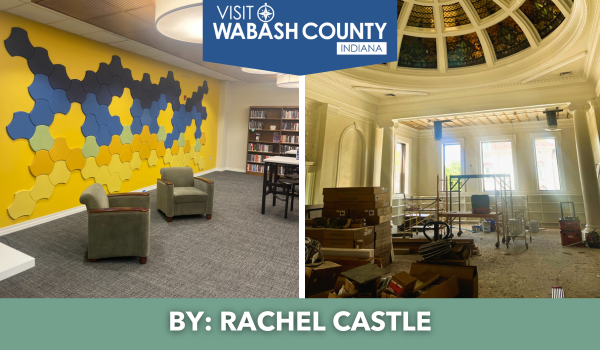How the Irish Built a Lasting Legacy in Wabash County
About an hour southwest of Fort Wayne in Wabash County, you’ll find Lagro. Though the town may be small, the legacy of the Irish in Lagro is far from modest. It was deeply influenced by the immigrants who put roots there and by the generations that followed.
The Irish’s impact is documented in the Wabash County Museum, where TJ Honeycutt, Director of Archives and Outreach, and his team welcome thousands of visitors each year. The museum showcases more than 175,000 pieces of Wabash County history and nearly 100 interactive exhibits.

Patrons are encouraged to explore the permanent collection, which contains items like military uniforms, family pictures, bibles, housewares, agriculture tools, furniture, and much more. Many of these pieces were donated by local families and help people of all ages understand how the county’s history informs the present.
Honeycutt says the arrival of the Irish changed Lagro’s trajectory in many ways. As reflected in the archives from Lagro’s mid-19h century era, a large amount of Irish heritage is present in Wabash County today.

“I would say the acknowledgment of that history is somewhat reduced, because of how hard it is to maintain your attachment to another country several hundred years later,” he says. “But it’s definitely present in religious practice here, in some families’ surnames and the names of places that are either related to Irish family names or Irish locations.”
Wabash County Historian and author Ron Woodward agrees with Honeycutt’s analysis. He’s a fount of information regarding the Irish’s contributions to the area, which he outlines in his book, “Hidden History of Wabash County, Indiana.”
Woodward says the largest wave of Irish immigrants came to the area in hopes of economic opportunity. The situation was dire back home and those who had the means fled overseas to make a living. Arriving on the East Coast, many found a niche in construction work and were eager to gain financial footing in a new place.

“Along the East Coast, especially in Maryland, Delaware, Pennsylvania and New York, there was this desire to get out to the West,” he says. “And they wanted a fast means to do it. So they began to dig canals. And the Irish gravitated towards that, following those canal-digging jobs from the East Coast and eventually to the Midwest.”
Enter the Wabash & Erie Canal project. Its purpose was to connect the Wabash River to Lake Erie. In 1827 the federal government provided Indiana with a land grant to aid in the construction of a new canal. It was in the early 1830s when the Irish began to arrive in droves to capitalize on this development. By 1853, Wabash and Erie Canal represented America’s longest canal at approximately 460 miles, according to the Indiana Historical Bureau.
Woodward estimates that as many as 1000 men worked on the canal between Fort Wayne and Wabash. Even more impressive than the number of laborers was the physical feat this project represented.
“They dug by hand,” he says. “They used spades and shovels. They had horses that would pull a shovel behind (them) and dig out the dirt, but mainly, it was grubbing and hoeing by hand.”
In other words, it was hard work and long hours, but it was also lucrative. Woodward says they earned about $13 a month, which was more than enough for a single laborer to afford a year’s worth of rent on only one month’s paycheck.

One of those early homes has survived as Wabash County develops. Built around 1835, these small dwellings housed Irish immigrants who came to the United States to work on the Wabash and Erie Canals.
Two enterprising business partners restored the only remaining canal house in Lagro that retains its original structure. Now an Airbnb rental, the Riparian House at 940 Washington St. blends historic elements with modern conveniences.
The structure’s one-room, open-floor plan includes a bedroom area, living room, dining spot, kitchen and adjoining bathroom. Guests can kayak or canoe on the river, walk or bike on the trail just steps from the Riparian back deck, or visit nearby state forests and historic Wabash.
Once settled in homes like the Riparian House. which were considered shanties at the time, the Irish immigrants began to put down deeper roots. For some, that meant establishing a spiritual home.
“The Irish Catholics in Lagro wanted to have church services,” says Woodward. “So they took over the building that had been built in 1826 for Miami Chief Lagro. It had been sitting empty for a while, so they took that over for church services and that was the beginning of St. Patrick’s Catholic Church.”
A nod to the patron saint of Ireland, the church community began to evolve as more Irish settled there. By 1835, there was a formal church established. Within five years, the structure was too small for the congregation, so they built another church, which would serve the needs of locals for the next 30 years. It was then that Bishop John Henry Luers laid the cornerstone for the present church located on West Main Street, on June 15, 1870. Bishop Joseph Dwenger dedicated the church on St. Patrick’s Day three years later.

Now classified by the Diocese of Fort Wayne-South Bend as an inactive parish, Woodward says the structure serves as a reminder of the Irish’s influence and impact on Lagro. Inside you’ll find a few key striking elements, like oak pews, a black walnut communion rail, and a walnut stairway carved by the pioneer parishioners with imported statues and stained glass. In 1999, it was listed on the National Register of Historic Places.
Though she lacks Irish ancestry, Lagro resident Becki Wagoner is one person who appreciates the church’s active role in Lagro’s history. She’s a member of the volunteer group, Friends of St. Patrick. The church was designated an oratory — or inactive parish — in 1997. Under then-Bishop John D’Arcy, the group formed to help keep the history of the church alive.
This is a charge Wagoner takes seriously. She considers the group spiritual and physical stewards of what she says is a “crown jewel” of Lagro.

“We use the church whenever possible, to bring people in to learn more about the history of Lagro and St. Patrick’s,” she says. “A few years ago, we had the American Organ Society. They were touring nationwide and they came to Lagro. They had a day there — they listened to our organ and ate dinner locally.”
The church’s organ is a gem in and of itself, says Wagoner. The group raised funds to restore it to its former glory, in 2005. She says it’s a treat to hear it and it’s especially rich when you consider the labor of love that went into this project.
“So now we have the 1840s organ playing in a 21st-century church,” she says.

On that note — pun intended — Wagoner says they’re preparing to celebrate the building’s 150th anniversary on March 17. Bishop Rhodes from Fort Wayne will be leading mass, and a choir from the Saints Peter and Paul parish in Huntington will be providing music.
“And then after Mass is over, we’re having a soup supper down at the United Methodist Church community building,” says Wagoner. “We’re hoping that everyone will go down from St. Patrick’s to reminisce and just have a very enjoyable evening.”
The event is open to the public.
***
In some ways, the Irish weren’t unlike many other immigrants in our nation’s history. They looked to America as a beacon of hope when the conditions in their homeland were fraught with uncertainty.

“The situation (in Ireland) was terrible in the early 1800s,” says Woodward. “To escape their poverty, most of them looked to the United States as an answer to their dreams.”
Lagro was one of the many cities and towns where this group made its mark on a country malleable and still in its infancy.
You can learn more about the Irish’s impact on Lagro and Wabash County at the Wabash County Museum, open Tuesday – Friday from 10 AM until 5 PM, and Saturday from 10 AM until 2 PM.
Wabash is the focus of our Partner City series underwritten by Visit Wabash County. This series will capture the story of talent, creativity, investment, innovation, and emerging assets shaping the future of Wabash County, about an hour Southwest of Fort Wayne.



